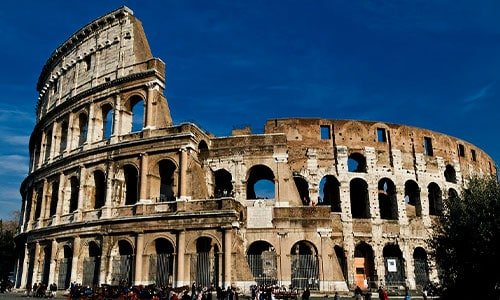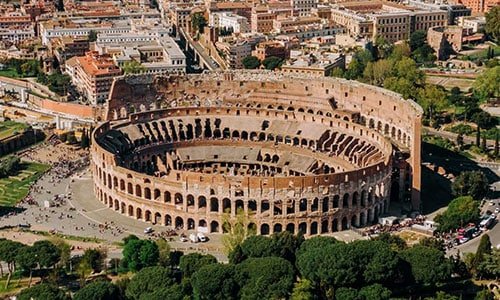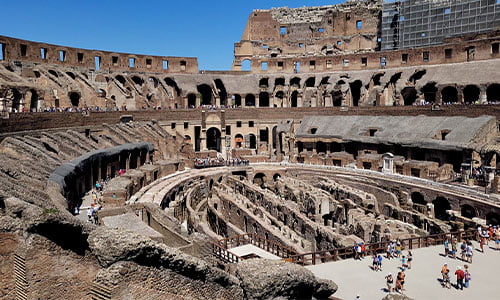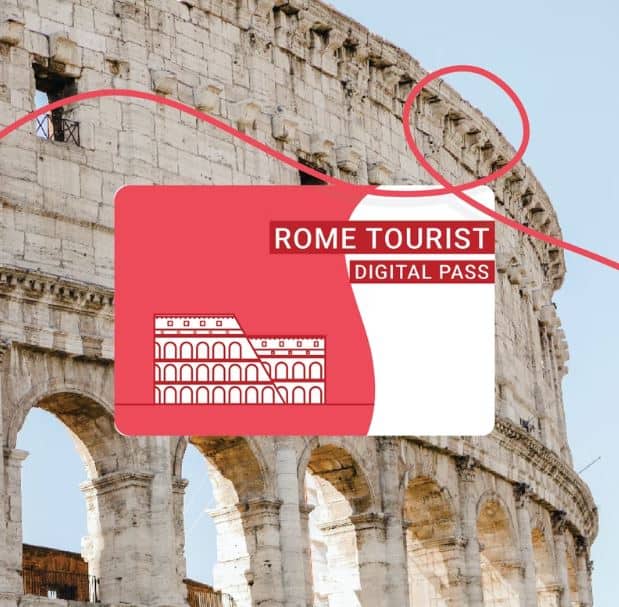THE COLOSSEUM
There is no doubt that visiting the Colosseum (or Coliseum) in Rome is a must for most first-time visitors to the city. With its fascinating history and complex architecture, the Flavian Amphitheatre, also known as the Colosseum, stands in the archaeological heart of Rome and welcomes a large number of visitors every day.
It was named the Colosseum because of a colossal statue located nearby. It was constructed by the Flavian dynasty in the 1st century CE. Animal hunts and gladiatorial games were popular spectacles until the end of the ancient period. Buildings such as this are spectacles in themselves, and remain so to this day. Featuring surprisingly complex stage machinery and spectator services, it is the largest amphitheater in the world.
This ancient structure today is a monument to the ingenuity and creativity of humankind. When viewed from the external arches, it presents a broad panorama of its interior spaces as well as striking views of the city.
AN OVERVIEW OF the colosseum history


Originally, the Colosseum was part of an extensive complex of structures serving a variety of purposes. As well as gladiatorial contests, it was used for a variety of other public events and performances. The Armamentarium, which stored weapons, was connected to several other buildings and structures (also via underground tunnels).
Around 72 CE, after Nero’s death and during the year of the three emperors, Vespasian (Titus Flavius Vespasian, who reigned from 1st July 69 CE to 24th June 79 CE) began the construction of the Colosseum. This massive building was constructed in only eight years. Under the reign of Vespasian’s son Emperor Titus, the Colosseum was inaugurated in 80 CE.
As a result of Titus’ legions’ conquest and sacking of Jerusalem in August and September of 70 CE, the Colosseum was probably funded with spoils.
The Flavian Amphitheatre (or Amphitheatrum Flavianum) was originally named after Vespasian’s new imperial dynasty, the Flavian Empire. Vespasian’s radical building intervention affected the entire area still occupied by Nero’s Golden House, as well as several buildings around the arena. Still exist some of the tunnels that connected these buildings.It took about twenty years to complete the complex until the end of Emperor Domitian’s reign, and the complex covered at least seven hectares.
Historically, the Colosseum was named after the Colossus of Nero, which was nearby. Accordingly, the name “Colosseum” comes from medieval times, when the Colossus probably was destroyed by an earthquake or the Sack of Rome in 410.
The Amphitheatre of Vespasian
A significant political decision was made by Vespasian by removing many of Nero‘s palace structures. He was, in effect, giving the area back to the people (as it had previously been a residential area) by constructing an amphitheater. Several channels were dug at a depth of 8 meters in order to drain underground water away from the site, a valley that had previously been filled with a lake.

Waste from public toilets at the Colosseum would be collected through these channels and sent to a sewer system around the building.Under the outer walls of the arena were a series of concentric concrete foundations ranging in depth from 13 meters to 4 meters.
After the Jewish War, which ended in 73 CE, as many as 100,000 prisoners may have been repurchased by Rome as slaves. The Colosseum was built by thousands of them under the supervision of hundreds of skilled stonemasons.
Who designed and planned the Colosseum?
In Roman legend, Gaudentius, the architect of the Colosseum, was a Roman nobleman who became a Christian martyr when he was killed in the arena he designed near the end of Domitian‘s reign when Christians were allegedly being persecuted.
An erroneous interpretation of an inscription found in the Roman Forum church of Saints Luke and Martina may have led to the creation of this fantastic legend in the seventeenth century. It is usually clear from inscriptions and historical sources who commissioned and paid for Roman monuments, but the names of their architects and designers are rarely known, as they were regarded as less important than the unskilled workers.
The structure of the Colosseum
The dimensions :
| Height of outer wall | 48.5 meters |
| Total length | 188 meters |
| Total width | 156 meters |
| Original outer perimeter length | 527 meters |
| Dimensions of the arena | 3357 m² |
Visiting the Colosseum and where to buy tickets
The Colosseum is an absolute must for any tourist visiting the Eternal City, but even many Romans who can find the time to rediscover this wonder of the ancient world should aspire to visit it. The ticket allows you access to the ground floor, the first floor, and part of the underground (hypogeum), as well as the partially reconstructed wooden arena floor.
colosseum skip the line tickets and guided tours – 2024
colosseum tickets prices
Be aware! It is almost exclusively possible to purchase tickets for the Colosseum online. Box office tickets are not easy to come by. It is therefore advisable to book your tickets online at all times. Ensure you book the right kind of ticket:
- Regular tickets (This combo ticket includes the Roman Forum and Palatine Hill) from 21.50 € (Book your tickets, or you can check more available on this website)
- 0 – 17 years 2 € and EU students 18 – 25 years 6 €
- Combi ticket + Arena Floor 29 € (Get your tickets now)
- Combi ticket + Video Guide 25 € (Get your tickets now)
- Combi ticket + Mamertine Prison 28 € (Get your tickets now)
You can get the Rome Tourist Card with all the tickets you need for your city break in Rome (such as the Colosseum, Forum Romanum, St. Peter’s Basilica, and Sistine Chapel). It will save you both time and money. Here is more information about the Rome Tourist Card.
Getting in for free:
- The first Sunday of the month is free entry (no reservations are accepted) – queues are expected to be long
- There is no admission charge for those under the age of 18 and discounted tickets for EU citizens between the ages of 18 and 25.
- With valid medical documentation of the disability, EU citizens with disabilities and their companions are free.
- EU and non-EU citizens under 18 and permanent or contract-based teaching staff in Italian schools get free entry on presentation of a valid ID.
Visit the official website of the Colosseum for more information
QUESTIONS AND ANSWERS
Can I skip the line with colosseum tickets?
The answer is yes. In the Colosseum, there are two entrances, one for advance ticket holders and one for those purchasing them on the spot. The advance ticket holder line is much shorter, so you’ll get inside much faster than if you show up without tickets. It’s important to spend less time in line in Rome during the summer when temperatures are high.
Is it possible to buy tickets for the Colosseum online?
Here you go! In just five minutes, you can book your tickets on our site, and you will receive them in your inbox.
In addition, audio guides are offered (in English) and discounted tickets are available for children.
Do I need to buy tickets in advance for the Colosseum?
A reservation is required for all visits to the Roman Colosseum. Booking your tickets online and in advance is the best way to avoid long lines. By doing so, you can choose a date and time that is convenient for you, but keep in mind that the Colosseum closes at a specific time.
What is included in Colosseum ticket?
The Full Experience Colosseum Arena ticket includes access to the Colosseum Arena Floor, ground level, and first level. Additionally, one entrance to the Roman Forum/Palatine Hill is included in the ticket price.
USEFUL INFORMATION
Opening days and times 2024
The Colosseum is open from 8.30 am to one hour before sunset depending on the season:
9.00 am – 7.15 pm
from 27th March to 31th August
9.00 am – 7.00 pm
from 1st September to 30 September
9.00 am – 6.30 pm
from 1st October to 30 October
9.00 am – 4.30 pm
dal 31 October to 31 December
last entry one hour before closing time
Ticket office
The ticket office closes one hour prior to Parco archeologico del Colosseo closing
Closed -January 1st and December 25
Price
Combined ticket to visit the Colosseum, the Roman Forum and the Palatine:
Adults: € 16
European Union members (18 – 24): € 2
Children (ages less than 17) and seniors (over 65) members of the EU: free entrance
How to get there
Address: Colosseum, Piazza del Colosseo 1, 00184 Roma, Italy.
Book online
Tickets & Tours for the Colosseum in 2024
ROME TOURIST PASS FOR COLOSSEUM, VATICAN AND ST PETER’S BASILICA
The Rome Tourist Pass includes tickets to three of Rome’s biggest attractions and some additional discounts.

